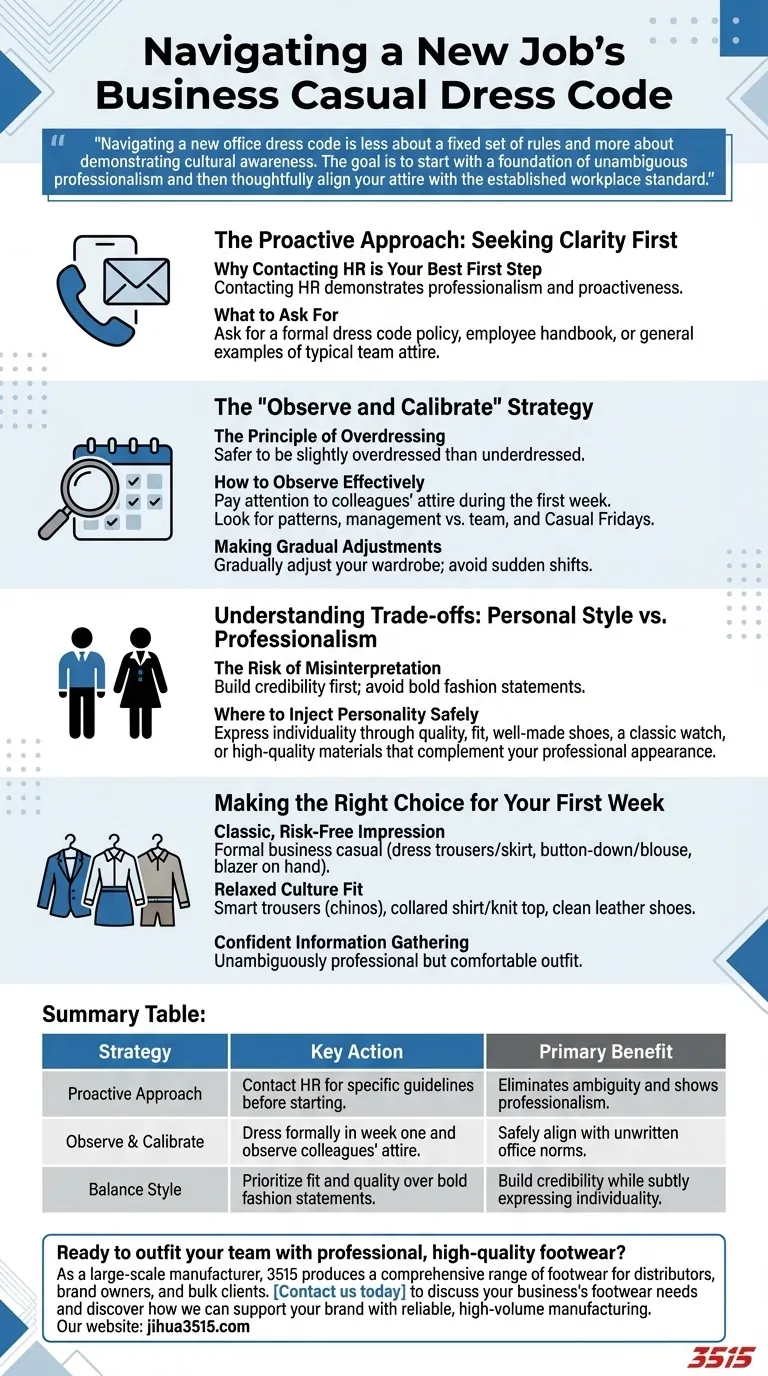To determine the right business casual attire for a new job, the most reliable method is to directly ask the Human Resources department for specific guidelines before your first day. If their guidance is vague, the safest and most professional strategy is to dress on the more formal side of business casual for your first week, observing your colleagues' daily attire to calibrate your own wardrobe for the weeks that follow.
Navigating a new office dress code is less about a fixed set of rules and more about demonstrating cultural awareness. The goal is to start with a foundation of unambiguous professionalism and then thoughtfully align your attire with the established workplace standard.

The Proactive Approach: Seeking Clarity First
Why Contacting HR is Your Best First Step
Contacting HR is not a sign of inexperience; it is a sign of professionalism. It demonstrates that you are proactive and care about aligning with company expectations from day one.
This simple act removes ambiguity and reduces the anxiety of the unknown, allowing you to focus on learning your new role instead of worrying about your outfit.
What to Ask For
When you reach out, ask if there is a formal dress code policy or an employee handbook you can review.
If a formal document doesn't exist, you can ask for general examples of what team members typically wear. This gives you a practical baseline to work from.
The "Observe and Calibrate" Strategy
The Principle of Overdressing
It is always safer to be slightly overdressed than even slightly underdressed.
Dressing more formally communicates respect for the new role and the organization. Underdressing, even unintentionally, can be misinterpreted as a lack of seriousness or care.
How to Observe Effectively
During your first week, pay close attention to the details of your coworkers' attire. Look for patterns in what management wears versus what individual contributors wear.
Notice if the dress code shifts throughout the week, such as a more relaxed "Casual Friday." This will give you a complete picture of the unwritten rules.
Making Gradual Adjustments
Once you have a clear understanding of the office norm, adjust your wardrobe gradually.
Avoid a sudden shift from a blazer and dress pants on Friday to jeans and a t-shirt on Monday. Slowly incorporate more casual elements to ensure your transition is seamless and natural.
Understanding the Trade-offs: Personal Style vs. Professionalism
The Risk of Misinterpretation
Your first few weeks are about building credibility and establishing a professional reputation. This is not the ideal time for bold fashion statements that could be misinterpreted.
The primary goal is to blend in first so that the quality of your work can stand out.
Where to Inject Personality Safely
You can express individuality without sacrificing professionalism by focusing on quality and fit.
Well-made shoes, a classic watch, or high-quality materials allow your personal style to show through in a subtle, polished way. The key is to choose accessories and pieces that complement, rather than dominate, your professional appearance.
Making the Right Choice for Your First Week
Your initial approach should be guided by the type of industry and your primary goal for making a first impression.
- If your primary focus is making a classic, risk-free impression: Default to the most formal version of business casual, such as dress trousers or a skirt, a button-down shirt or blouse, and have a blazer on hand.
- If your primary focus is fitting into a potentially more relaxed culture: Start with smart trousers (like chinos), a collared shirt or quality knit top, and clean, non-athletic leather shoes.
- If your primary focus is simply gathering information with confidence: Choose an outfit that is unambiguously professional but also comfortable, ensuring you aren't distracted by what you're wearing.
Ultimately, dressing appropriately is the first step in showing that you are observant, respectful, and ready to become a valued member of the team.
Summary Table:
| Strategy | Key Action | Primary Benefit |
|---|---|---|
| Proactive Approach | Contact HR for specific guidelines before starting. | Eliminates ambiguity and shows professionalism. |
| Observe & Calibrate | Dress formally in week one and observe colleagues' attire. | Safely align with unwritten office norms. |
| Balance Style | Prioritize fit and quality over bold fashion statements. | Build credibility while subtly expressing individuality. |
Ready to outfit your team with professional, high-quality footwear?
As a large-scale manufacturer, 3515 produces a comprehensive range of footwear for distributors, brand owners, and bulk clients. Our production capabilities encompass all types of shoes and boots, ensuring your team looks polished and professional from day one.
Contact us today to discuss your business's footwear needs and discover how we can support your brand with reliable, high-volume manufacturing.
Visual Guide

Related Products
- Wholesale Customizable Suede Safety Boots - Puncture-Proof with Velcro Closure
- Customizable Slip-On Safety Shoes Direct from the Factory for Wholesale
- Wholesale Leather Derby Shoes Manufacturer | Customizable Business & Dress Footwear
- Durable Leather Work Boots Wholesale Manufacturer & Custom Factory
- Wholesale Durable 6-Inch Work Boots | Custom & Private Label Manufacturer
People Also Ask
- Why is maintenance important for work boots? Protect Your Investment and Safety
- What are the potential consequences of wearing improperly designed work boots? Avoid Injury & Boost Safety
- What is the purpose of ASTM International? A Guide to Global Quality Standards
- What cultural and environmental considerations are tied to wearing shoes indoors? Balance Hygiene, Tradition, and Foot Health
- How does toe box design differ between men's and women's work boots? Fit for a Woman's Foot Anatomy



















